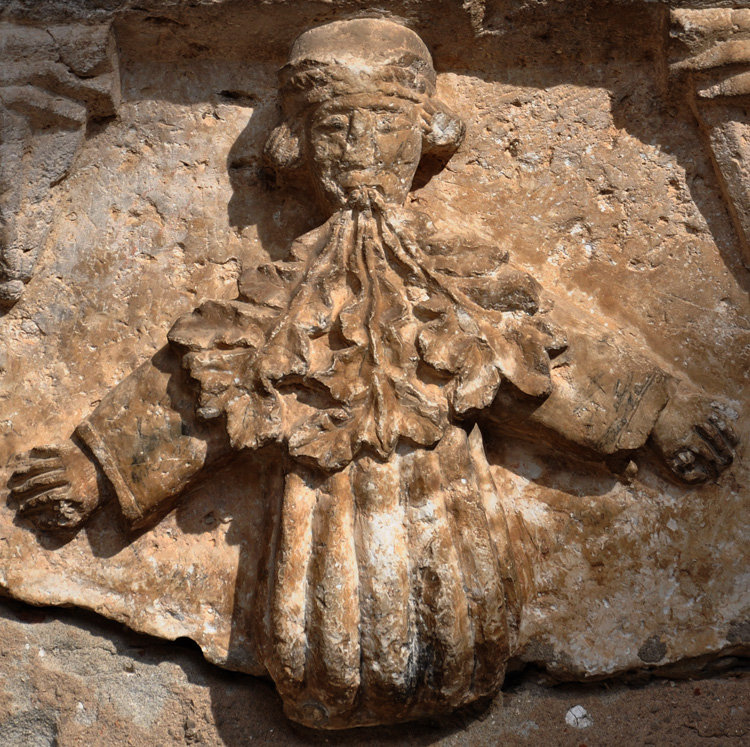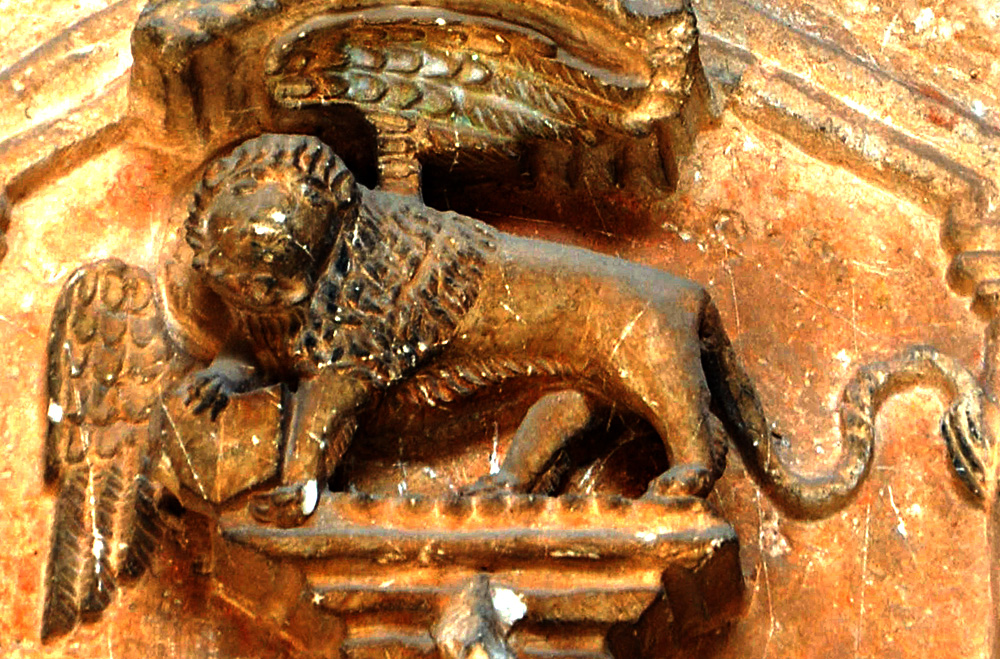 At the bottom is a "green man." "Green man" reliefs and sculptures are common in medieval cathedrals, and quite a few have foliage issuing from the mouth. (See Wikimedia Commons and search on "green man." for examples.) Most other green men, however, are thoroughly wild in appearance, with foliate clothing and hair. This little fellow has a civilized cap and pleated gown with cuffed sleeves and natural hands and face.
At the bottom is a "green man." "Green man" reliefs and sculptures are common in medieval cathedrals, and quite a few have foliage issuing from the mouth. (See Wikimedia Commons and search on "green man." for examples.) Most other green men, however, are thoroughly wild in appearance, with foliate clothing and hair. This little fellow has a civilized cap and pleated gown with cuffed sleeves and natural hands and face.
 Above the inscription, the middle register of the plaque appears to be an Annunciation, although this is problematical. The female figure on the left has
a rose-shaped brooch
like those sometimes seen in images of Mary, and she crosses her arms over her chest, a conventional signifier of humility that is seen in some Annunciation images
(example). The problem is the figure on the right. He is in an architecturally separate field, as Gabriel very often is in Annunciation images, and he is beardless as angels always are. But he does not seem to have wings, and the closed book in his left hand is something Gabriel never holds in other Annunciations. Further, above the fringe of hair he seems to have a tonsure, which angels never have. So it is possible that the two figures are two saints who cannot now be identified — or, much less likely, the Virgin Annunciate and a sainted monk.
Above the inscription, the middle register of the plaque appears to be an Annunciation, although this is problematical. The female figure on the left has
a rose-shaped brooch
like those sometimes seen in images of Mary, and she crosses her arms over her chest, a conventional signifier of humility that is seen in some Annunciation images
(example). The problem is the figure on the right. He is in an architecturally separate field, as Gabriel very often is in Annunciation images, and he is beardless as angels always are. But he does not seem to have wings, and the closed book in his left hand is something Gabriel never holds in other Annunciations. Further, above the fringe of hair he seems to have a tonsure, which angels never have. So it is possible that the two figures are two saints who cannot now be identified — or, much less likely, the Virgin Annunciate and a sainted monk.
 At the top is a griffin, a mythical creature part-bird and part-lion. It can represent either Christ or the anti-Christ and is a favorite feature of medieval heraldry (Sill, 21). The latter context is possible in the case of this plaque, because of the heraldic shield in the middle register. The anti-Christian denotation (see
this example) is clearly inapplicable here, but the use of the griffin to represent Christ makes good sense. As Sinclair puts it in explaining the Griffin in Purgatorio XXIX, it "represents not so much Christ as the theological idea of Christ, the mystery of the divine and human natures" (Dante's Purgatorio, 389). We might think of the plaque as a whole as a meditation on this theological duality. At the top the griffin symbolizes the human and divine. At the bottom the green man in pleated gown symbolizes forest and town. And in the center the Virgin Annunciate points us to the Incarnation, the "impossible union / Of spheres of existence [where] past and future / Are conquered, and reconciled.…" ("The Dry Salvages," 216-19).
At the top is a griffin, a mythical creature part-bird and part-lion. It can represent either Christ or the anti-Christ and is a favorite feature of medieval heraldry (Sill, 21). The latter context is possible in the case of this plaque, because of the heraldic shield in the middle register. The anti-Christian denotation (see
this example) is clearly inapplicable here, but the use of the griffin to represent Christ makes good sense. As Sinclair puts it in explaining the Griffin in Purgatorio XXIX, it "represents not so much Christ as the theological idea of Christ, the mystery of the divine and human natures" (Dante's Purgatorio, 389). We might think of the plaque as a whole as a meditation on this theological duality. At the top the griffin symbolizes the human and divine. At the bottom the green man in pleated gown symbolizes forest and town. And in the center the Virgin Annunciate points us to the Incarnation, the "impossible union / Of spheres of existence [where] past and future / Are conquered, and reconciled.…" ("The Dry Salvages," 216-19).
Below the griffin are two male saints flanking an angel. On the left a saint in a chasuble holds a book and a maquette of a church. In Croatia this is the typical way of picturing St. Jerome, but the present figure lacks Jerome's usual attributes (lion, cardinal's hat). On the right a bishop saint, also in a chasuble and wearing a mitre, holds a book in his right hand and possibly a now-lost crozier in his left. In Croatia St. Jerome is often pictured with a maquette of a church The other figure could be any bishop saint. Neither figure is likely to be St. Maurus, the martyred patron saint of Poreč, because neither has a palm branch.
If this is indeed an Annunciation we can date the plaque as 14th century or later, because it was in the 14th that western Annunciations started giving the Virgin Annunciate a gesture of humility like the one seen here.
 The shield below the central frame features vertical stripes of two alternating "colors." It is reminiscent of the two-stripe shield of Poreč, at right, where the basilica is located.
The shield below the central frame features vertical stripes of two alternating "colors." It is reminiscent of the two-stripe shield of Poreč, at right, where the basilica is located.
View this image in full resolution.
Read more about images of the Annunciation.
